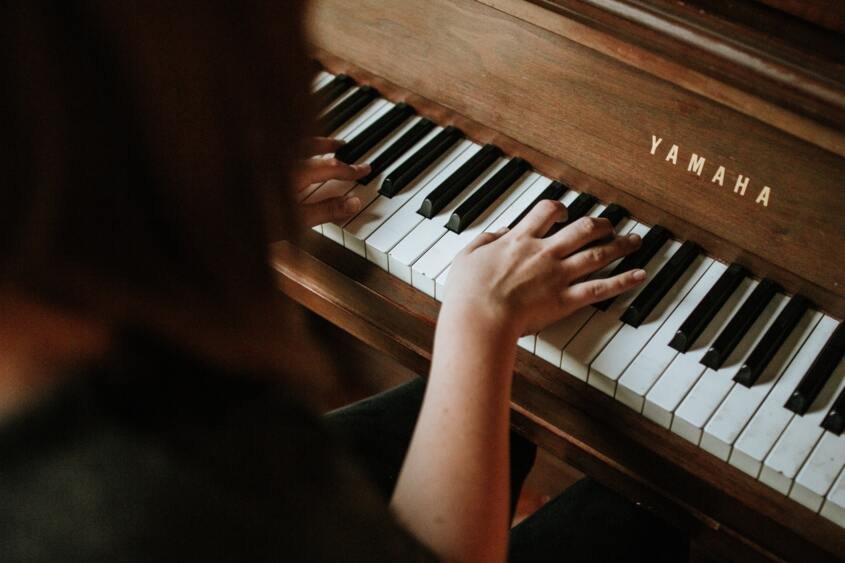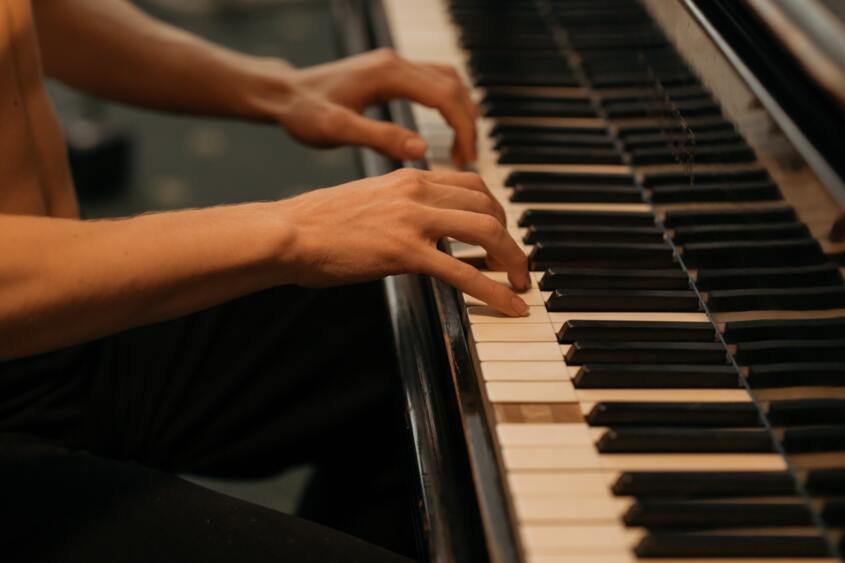Warm-up Piano Exercises For Beginners
Warming up your muscles is essential before playing the piano, as it is with any form of physical exercise. It is required to avoid injuries that can occur during your musical activities.
This warming-up is not only physical but also mental. When you warm up before playing the piano, you prepare your mind to sit before the piano and soothe your soul.
The following exercises are for beginners and ideal for someone who’s just starting. But before diving into the exercises, let’s look at the importance of warming up before a practice session.
Importance of Warming-up Before Piano Practice
Scales and arpeggios are not used in conventional piano techniques to torment you. It is done to develop your skills, finger control, and flexibility. Warming up is important for pianists since they usually play more notes per piece than other instruments. Let's look at the significance of warming up and some of the advantages of doing so before you begin your practice routine.
1. Preventing Injuries
You might be wondering how it is possible to injure yourself when playing the piano. The truth is that good piano playing is dependent on good posture, relaxed arms, strong wrists, flexible hands, and fast fingers.
As your hands move rapidly and spread over the keys when playing, you can injure your muscles, similar to the way athletes get hurt due to improper movement.
2. Muscle Memory
The first time you sit in front of the piano, you may feel uncomfortable and odd with your hand positions and movements. This is where muscle memory comes in handy.
Warming up allows the fingers, wrists, and hands to become more familiar with the positions and movements.
When you repeat similar warm-up exercises before your practice routine, your hands become more comfortable and familiar. This helps to strengthen muscle memory, which is one of the most critical aspects of learning any instrument.
Warming up often allows the muscles to become accustomed to playing difficult melodic patterns or variations, long and short phrases, and quick and slow tempos.
Stretch! Stretch! and Stretch!
There’s no alternative to stretching before any kind of exercise and we all know that. So before warming up, you need to stretch your hands and get ready.
When you play the piano, you use certain muscles and tendons to play the keys. Thus, stretching for a few seconds is a vital part of warming up.
Many young pianists have had carpal tunnel syndrome in the past, and so, stretching is now considered a must-perform exercise. You would rather spend 5-10 minutes warming up than spend 5-10 months in pain.
Now, before you start doing warm-up exercises, you should first work on fixing your position in front of the piano.
Sitting Position
There are some tips you should acknowledge while you sit to play the piano, such as:
- Firstly, don’t sit too close to your piano. Many young learners make the mistake of sitting too close to the piano. However, you need space to move your hands.
As a general rule, the center of your knees has to be in the same position as where the keyboard starts. If you draw a straight line down from where your keyboard starts, it should meet with your knees in the center.
- Secondly, we would recommend that you just use the front half of your chair. Don't sit all the way in the back because it restricts your movements and can even impair blood flow in your legs. Sit on the very edge of your chair.
- Finally, adjust the height of your chair so that you can relax your shoulders when tapping on the keyboard without having to bend your wrists. Your fingers ought to have a natural curve.
If you're not using a height-adjustable chair, a set of pillows should suffice.
Some Warm-up Exercises For Beginners
1. The 5-Finger Walk

Photo by Jordan Whitfield on Unsplash
In this warm-up exercise, each finger on each of your hands is assigned a number from 1 to 5, beginning with your thumb, which is one and ending with your pinky finger, which is assigned the number five. The numbers for the left and right hands are the same.
With this exercise, you will also learn how to locate the middle "C" key on your keyboard. It's easy so do not worry.
This exercise will allow you to walk over the first 5 notes of the C-major scale, but we won't think about that yet.
You'll start with your right hand, then your left, and finally both hands at the same time.
We suggest this product from Amazon to best practice before starting your lesson to get the best results!
For more information Click Here!
2. Playing The Pattern With Both Hands
If you've completed the pattern with each hand, it's time to use both hands.
You could play the pattern with both hands, but we recommend making pauses. So, with your left hand, play and hold the C-note while playing the pattern with your right hand.
After you've completed the pattern with your right hand, keep the C with your right thumb and continue with your left.
Continue to alternate. It's like an echo, and it makes the brain work a little harder.
3. Staccato Arpeggio
Arpeggios can be a fantastic exercise that can transform your playing tone and make the rhythm sound all the more soothing.
We'll be doing arpeggios staccato here, which means it’s going to be super swift and bouncy.
Practice an arpeggio with your dominant hand first, then with the other hand, and finally with both hands together.
To make this more musical, we recommend using a chord progression.
So, in the key of C, you can begin with arpeggios on C.
Then move to A, F, and lastly G.
These four chords are the most popular in pop music, and they sound great!
4. Three Notes Arpeggio
During this exercise, you will feel as though you are playing real music. You'll have to play a broken chord, also known as an arpeggio.
You should be playing the C-major chord in its most simple form, but don't worry if it sounds boring. The harmonics will soon start sounding brilliant.
5. Octave Scales
This is the final warm-up exercise. Simply, just bounce up and down the scale using octaves.
This can be a difficult stretch for some people, so make sure you're not experiencing any pain or anxiety while playing.
The notes will be played together in an octave by one hand, while the other will bounce between the notes.
Then, change hands. Hold the octave with your right hand while playing the notes with your left!
Some Other Tips for Better Results
- If you plan to warm up with standard techniques and exercises, make sure to play a wide range of scales, arpeggios, and chords suitable for your level of competence. Be mindful of the musicality and don't repeat it mindlessly.
- Practice regularly and slowly. Just as athletes take things slowly at the start of a training session, so should you. You have more command when you practice slowly. You become more conscious of the music and your response to it.
- Instead of doing the normal warm-up drills, try sight-reading. Your reading skills will continue to improve over time, which will help your overall piano training.
Personalize The Exercises In Your Own Way

Photo by cottonbro from Pexels
All of these activities aim to engage your brain in a particular way in order to keep you engaged and concentrated while you prepare physically. It's all about stimulating your brain while your body does the necessary work.
A fun way to do this is to pick some simple collection that you already know and make a sudden, big change to it.
It could be attempting to perform a pop song in a reggae theme or dramatically speeding up a Chopin ballade.
This is an artistic, compositional exercise that will help you understand genre, tempo, and rhythm and can lead you to discover some very interesting sides of the piano.
And do not be afraid to experiment from time to time. The more interesting your warm-up routine, the better off you will be with the practice session. It will not only save you from being bored and irritated, but it will also help accelerate your progress in the long run.
Revision - A Must
Your warm-up exercises should conclude with a fast review of the main parts from the previous practice session to ensure they haven't been overlooked and that you're prepared to move on to whatever comes next.
This does not have to be extremely rigorous and thorough; it is simply about covering the familiar ground before moving on. So, put yourself to the test, and use some of the exercises described above to spice things up!
Taking A Step Forward
You completed the first round of warm-up exercises! Congratulations, give yourself a pat on your back. You should be able to play the piano without getting hurt or injured now that you've warmed up to start practicing properly.
If you need help finding a piano tutor who will guide you in this process, The Best Piano Teachers is here for just that. Feel free to reach out to us whenever you need further assistance.
Which of these warm-up exercises do you start with your piano lessons with? Let us know in the comments below!
Remember that as you warm up, you are relaxing the muscles in your hands and wrists. It is critical to establish a warm-up routine in order to relieve the stress and before beginning your piano playing sessions.
Warming up is important because it will prepare your mind and body to communicate better as you push beyond the limits of your music and look to the future to explore your personal journey of making music.

1 Comment
verlaine
Very helpful